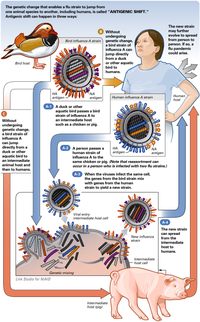Swine Influenza
Swine influenza (also called swine flu, hog flu, or pig flu) is an infection by any one of several types of swine influenza virus. Swine influenza virus (SIV) is any strain of the influenza family of viruses that is endemic in pigs. As of 2009, the known SIV strains include influenza C and the subtypes of influenza A known as H1N1, H1N2, H3N1, H3N2, and H2N3.
Swine influenza virus is common throughout pig populations worldwide. Transmission of the virus from pigs to humans is not common and does not always lead to human influenza, often resulting only in the production of antibodies in the blood. If transmission does cause human influenza, it is called zoonotic swine flu. People with regular exposure to pigs are at increased risk of swine flu infection. The meat of an infected animal poses no risk of infection when properly cooked.
During the mid-20th century, identification of influenza subtypes became possible, allowing accurate diagnosis of transmission to humans. Since then, only 50 such transmissions have been confirmed. These strains of swine flu rarely pass from human to human. Symptoms of zoonotic swine flu in humans are similar to those of influenza and of influenza-like illness in general, namely chills, fever, sore throat, muscle pains, severe headache, coughing, weakness and general discomfort. The recommended time of isolation is about five days.
Spanish flu
The Spanish flu, also known as La Gripe Española, or La Pesadilla, was an unusually severe and deadly strain of avian influenza, a viral infectious disease, that killed some 50 to 100 million people worldwide over about a year in 1918 and 1919. It is thought to be one of the most deadly pandemics in human history.
The 1918 flu caused an unusual number of deaths, possibly due to it causing a cytokine storm in the body.[2][3] (The current H5N1 bird flu, also an Influenza A virus, has a similar effect.)[4] The Spanish flu virus infected lung cells, leading to overstimulation of the immune system via release of cytokines into the lung tissue. This leads to extensive leukocyte migration towards the lungs, causing destruction of lung tissue and secretion of liquid into the organ. This makes it difficult for the patient to breathe. In contrast to other pandemics, which mostly kill the old and the very young, the 1918 pandemic killed unusual numbers of young adults, which may have been due to their healthy immune systems mounting a too-strong and damaging response to the infection.[5]
The term "Spanish" flu was coined because Spain was at the time the only European country where the press were printing reports of the outbreak, which had killed thousands in the armies fighting World War I. Other countries suppressed the news in order to protect morale.[6]
Fort Dix outbreak
In 1976, a novel swine influenza A (H1N1) caused severe respiratory illness in 13 soldiers with 1 death at Fort Dix, New Jersey. The virus was detected only from January 19 to February 9 and did not spread beyond Fort Dix.[7]
Russian flu
- See Influenza A virus subtype H2N2#Russian flu for the 1889–1890 Russian flu
The 1977–1978 Russian flu epidemic was caused by strain Influenza A/USSR/90/77 (H1N1). It infected mostly children and young adults under 23 because a similar strain was prevalent in 1947–57, causing most adults to have substantial immunity. The virus was included in the 1978–1979 influenza vaccine.[8][9][10][11]
2009 A(H1N1) pandemic

In the 2009 flu pandemic, the virus isolated from patients in the United States was found to be made up of genetic elements from four different flu viruses – North American swine influenza, North American avian influenza, human influenza, and swine influenza virus typically found in Asia and Europe – "an unusually mongrelised mix of genetic sequences."[12] This new strain appears to be a result of reassortment of human influenza and swine influenza viruses, in all four different strains of subtype H1N1.
Preliminary genetic characterization found that the hemagglutinin (HA) gene was similar to that of swine flu viruses present in U.S. pigs since 1999, but the neuraminidase (NA) and matrix protein (M) genes resembled versions present in European swine flu isolates. The six genes from American swine flu are themselves mixtures of swine flu, bird flu, and human flu viruses.[13] While viruses with this genetic makeup had not previously been found to be circulating in humans or pigs, there is no formal national surveillance system to determine what viruses are circulating in pigs in the U.S.[14]
On June 11, 2009, the WHO declared an H1N1 pandemic, moving the alert level to phase 6, marking the first global pandemic since the 1968 Hong Kong flu.[15]
On October 25, 2009 U.S. President Barack Obama officially declared H1N1 a national emergency[16]
November 8, 2009 worldwide update by the U.N.'s World Health Organization (WHO) states that "206 countries and overseas territories/communities have officially reported over 503,536 laboratory confirmed cases of the influenza pandemic H1N1 infection, including 6,250 deaths." [1]








Tidak ada komentar:
Posting Komentar